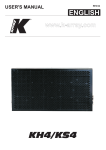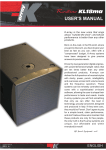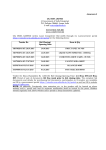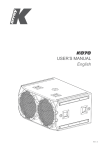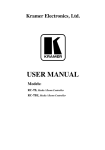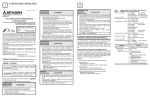Download K Array Line KH4/KS4/KH15
Transcript
USER'S MANUAL ENGLISH K Array Line KH4/KS4/KH15 SAFETY INSTRUCTIONS CAUTION This symbol, wherever it appears, alerts you to important operating and maintenance istructions in the accompanying literature. Read the manual! Detailed Safety and Operation Instructions: All the operation instructions and safety should be read before the machine is operated. Follow instructions: All operation and user instructions should be followed by the user or the installer. Retain Instructions: The safety and operating instructions should be carefully retained for future reference. Heed Warnings: All warnings on the machine and in the operating instructions should be adhered to. Water and Moisture: The machine should not be used near water or in place full of moisture. Ventilation: The machine should be placed so that its location does not interfere with its proper ventilation. For example, the appliance should not be situated on a bed, carpet, or similar surface that may create an obstacle for the ventilation openings: or placed in a built-in installation, such as a bookcase or cabinet that may impede the flow of air around the machine. Heat: The machine should be situated far away from heat sources such as heat registers, radiators, stoves, or other machines (including amplifiers) that produce heat. Power-Cord Protection: Power supply cord should be routed so that it is not likely to be walked on or pinched by items placed upon or against it, paying particular attention to cords. Cleaning: The machine should be cleaned only as recommended by the manufacturer. Object and Liquid Entry: Care should be taken so that objects do not fall and liquids are not spilled into the enclosure through openings, do not leave bottles or cans upon the unit. Damages that Require Service: The unit should be serviced by qualified service personnel in the following cases: 1. The external power cord or the plug has been damaged. 2. The enclosure of the unit has been damaged. 3. The unit has been exposed to water or moisture. 4. The unit does not appear to operate normally or exhibits a marked change in performance. 5. Objects have fallen, or liquid has been spilled into the unit. Servicing: The user should not attempt to service the unit beyond what is described in the Operating Instructions. All other servicing should be referred to qualified and authorized service personnel. USER'S MANUAL P. 1 TABLE OF CONTENTS 1 INTRODUCTION p. 3 2 AC Power Distribution p. 4 3 Voltage Requirements p. 4 4 Current Requirements p. 5 5 Power connector wiring p. 5 6 Connections p. 6 7 Amplification & protection circuitry p. 6 8 DSP & REMOTE control p. 7 9 DSP & REMOTE control software p. 8 10 Power supply & audio section p. 14 11 System configurations p. 15 11.1 System coverage p. 16 11.2 Short installation manual p. 16 12 System configurations on floor p. 17 13 Variable vertical coverage p. 17 14 System configurations (KH15) p. 18 15 Suspending manual p. 19 16 Maintenance of the system p. 20 17 Default speaker presets p. 21 18 Details & Accessories p. 22 19 Physical p. 22 KH4 Presets p. 23 KH15 Presets p. 24 KS4 Presets p. 25 Polar response p. 26 NOTES p. 27 USER'S MANUAL P. 2 1. INTRODUCTION K-array is the new voice that sings aloud, "outside the chorus", and whose performance is better than any other products. Born on-the-road, in the PA world, where you get no discount, you have to give your best as fast as you can, often with a "compressed" budget, K-Array systems have been designed to give precise answers to precise needs. K-Array systems are driven by new generation digital engines, with power/dimension/weight ratios that are ten times better than any other professional products; these systems can be remotely controlled and come with a lot of on-board software. K-array systems can shape their performance following your taste and needs. Inside K-array systems you will find something that only K-array can offer: the best in technology, proudly conceived, designed and produced in Italy. If they were cars, they would be Ferrari. Don't agree to pay for a simple brand, claim performance, and don't believe those who maintain that these products are only for few people, the only truth is that K-array systems are unique, but affordable and within everybody's reach! HP Sound Equipment USER'S MANUAL P. 3 2. AC POWER DISTRIBUTION All amplifier modules and the rest of the audio equipment connected to it (mixing consoles, processors, etc.) must be connected to the AC power distribution in a properway, preserving AC line polarity and connecting earth ground such that all grounding points are connected to a single node or common point using the same cable gauge as the neutral and line(s) cables. Bad grounding connections between speakers and the rest of the audio system may produce noise, hum and/or serious damage to the input/output stages in the system’s electronic equipment. CAUTION Before applying AC to any K-array self-powered speaker, be sure that the voltage potential difference between neutral and earth ground is less than 5 VAC. 3. VOLTAGE REQUIREMENTS The KH4 or KS4 operates safely and without audio discontinuity if the AC voltage stays within either of two operating windows: 95-125 or 195-250 V, at 50 or 60 Hz. WHEN YOU SWITCH ON THE UNIT: The main power supply slowly ramps on t he green display on the user panel lights up, and the green leds on the left side lights up flashing, indicating that the system is enabled and ready to process audio signals CAUTION If the Display does not illuminate or the system does not respond to audio input after ten seconds, remove AC power immediately. Verify that the voltage is within the proper range. If the problem persists please contact HP Sound Equipment or an authorized service center. NOTE It is recommend that the supply be operated in the rated voltage windows, at least a few volts away from the turn on/off points so that small AC voltage variations do not cause the amplifier to cycle on and off. USER'S MANUAL P. 4 4. CURRENT REQUIREMENTS The KH4 or KS4 presents a dynamic load to the AC mains, which causes the amount of current to fluctuate between quiet and loud operating levels. Since different cables and circuit breakers heat up at varying rates, it is essential to understand the types of current ratings and how they correspond to circuit breaker and cable specifications. The maximum continuous RMS current is the maximum RMS current in a period of at least ten seconds. It is used to calculate the temperature increase in cables, which is used to select cables that conform to electrical code standards. It is also used to select the cable size and gauge and the rating for slow-reacting thermal breakers. The maximum burst RMS current is the maximum RMS current in a period of approximately one second. It is used to select the rating for most magnetic breakers. The maximum instantaneous peak current during burst is used to select the rating for fast-reacting magnetic breakers and to calculate the peak voltage drop in long AC cables according to the formula: V pk (drop)= I pk x R (cable total) For best performance, the AC Cable voltage drop should not exceed 10 Volts, or 10% at 115V and 5% at 230V. Use Table 1 below as a guide when selecting cable gauge size and circuit breaker ratings for your operating voltage. The minimum electrical service amperage required by a system of KH4 or KS4 is the sum of their maximum continuous RMS current. We recommend allowing an additional 30% above the minimum amperage to prevent peak voltage drops at the service entry. KH4 and KS4 Current Rating: 115 VAC = 20A Max Continuous RMS 230 VAC = 10A Max Continuous RMS 5. POWER CONNECTOR WIRING CONVENTIONS The KH4 or KS4 requires a grounded outlet. It is very important that the system be properly grounded for both safety and proper operation. Use the following wiring diagram to create power cables and distribution systems. CAUTION The KH4 or KS4 requires a ground connection. Always use a grounding outlet when connecting these units. CAUTION Do not operate the unit if the power cables are frayed or broken. CAUTION Keep all liquids away from the KH4 or KS4 amplifiers to avoid hazards from electrical shocks. USER'S MANUAL P. 5 6. CONNECTIONS The KH4 or KS4 presents a 10k ohm balanced input impedance to a three-pin XLR connector with the following connectors: pin1 = Ground pin2 = Signal + pin3 = Signal - CAUTION Shorting an input connector pin to the case can form a ground loop and cause hum. Pins 2 and 3 carry the input as a differential signal; pin 2 is hot relative to pin 3, resulting in a positive pressure wave when a positive signal is applied to pin 2. Use standard audio cables with XLR connectors for balanced signal sources. Make sure that pin 1 (shield) is always connected on both ends of the cable. If abnormal noises such as hiss and popping are produced by the loudspeaker, disconnect the audio cable from the speaker. If the noise stops, then most likely the problem is not with the loudspeaker. Check the audio cable, source, and AC power for the source of the problem. Audio signals can be easy-chained using the loop output connector on the user panel of the KH4 or KS4. A single source can drive multiple KH4 or KS4 with a paralleled input loop, creating an unbuffered hard-wired loop connection. When driving multiple KH4 or KS4 in an array, make certain that the source device can drive the total load impedance presented by the paralleled input circuit of the array. The audio source must be capable of producing a minimum of 20 dBV (10-Vrms into 600 ohms) in order to produce the maximum peak SPL over the operating bandwidth of the loudspeaker. 7. AMPLIFICATION AND PROTECTION CIRCUITRY The KH4 or KS4 is powered by the K-array power amplifiers, a high-power eight-channel digital amplifiers (500 watts/ch. RMS) with a total power of 4000 watts. All the specific functions for the KH4 or KS4 such as crossovers, frequency, phase response, and driver protection are determined by a DSP processor installed inside the amplifier. All K-array loudspeakers are shipped with the drivers in correct alignment. However, if a driver needs to be replaced, make sure the replacement is reinstalled with the correct polarity. Incorrect driver polarity impairs the system performance and may damage the drivers. USER'S MANUAL P. 6 8. DSP CONTROL & REMOTE CONTROL KH4, KS4 and KH15 have a powerful DSP that manages all the functions of the speakers. Each system can store on board 16 preset that can be recalled pushing the PRESET button. Once the preset will appear on the lower line of the display it will become automatically available after few seconds. If you desire to set a preset as “default” you just need, once selected it, to keep pressed for five seconds the PRESET button. After that, this preset will automatically be recall each time you will switch on your module. It is also possible to remote each module by an RS485 serial port. In order to remote your system, you need to set each module on a different address, so that, in your chain, no one module will have the same address. Two rotary encoders allow you to set the desired address number that will appear on the top line of the display. Using the remote control software it is possible to mute each system, select a desired preset loaded on-board or download a new preset pack. For remote control operation please refer to REMOTE CONTROL AND SOFTWARE MANUAL in the next pages. FROM PC OR PREVIOUS MODULE TO NEXT MODULE ADDRESS FOR REMOTE CONTROL PRESET LOADED ADDRESS X 10 ADDRESS X 1 RESET BUTTON PRESET SCROLL CAUTION Connecting more than 3 modules by RJ45 8 poles cable, the display of the last off module will start lighting. CAUTION To connect high quantity of modules together by remote control, it suggested to use K-array special 3 pole cables or XLR adapters. USER'S MANUAL P. 7 9. DSP REMOTE CONTROL SOFTWARE The K array System control software is organized in frames. Each frame contains one or more buttons witch goal is to realise a particular function. This is the first frame that appear: pic. 5.1.1 This frame describes the state of all the loudspeakers on the net (see picture 5.1.1). The colour of the little rectangles into this frame represents the status of the loudspeakers. Each loudspeaker has three rectangles. Here there is the meaning of the rectangle's colour. Two rectangles on top: Both rectangles grey: the loudspeaker is not present on the net. Temperature rectangle red: at least one module inside that loudspeaker is over-temperature. Temperature rectangle green: all modules inside that loudspeaker have a good temperature. Protection/Fail rectangle red: at least one module inside that loudspeaker is in protection. Temperature rectangle green: all modules inside that loudspeaker are working properly. Temperature rectangle black: if this rectangle is black it means that the loudspeaker is not responding. The main causes of this malfunction are loss of power supply and loss of serial connection between the hub and the loudspeaker. Check the hardware. If this rectangle is black will be black also the Protection/Fail. Protection/Fail rectangle black: see above. The remaining rectangle: Is related to the mute function; if red, the related loudspeaker is in "mute" status. 9.1.1 Updating the loudspeaker list This frame (see picture 5.1.1) contains a button called "Update". When the program is starting up, it searches for all the loudspeakers present on the net. Thus, when the program starts it highlights the IDs of all the loudspeakers present on the net. The IDs are arranged by increasing order. The goal of the button called "Update" is to refresh the status of all the net. You have to use this button if there are changes about one or more loudspeakers. For example if you change a descriptor of a loudspeaker, you will not see any change on the form until you press the "Update Loudspeakers List" button. Another example is if you put a new loudspeaker on the net or if a loudspeaker changes his ID. The program will not reflect these changes until you press the "Update Loudspeakers List" button. 9.1.2 The "Serial Port" frame This program has a frame called "settings" (see picture 5.1.2); when the program is starting up, it detects all the serial ports (COM) present on the PC and puts it on the combo box. The program also detects which port is connected to the K-array USB adapter and uses it to "talk" with all the loudspeakers. If your K-array USB adapter is not connected to the PC via COM ports, or there are hardware or cables connection problems, the program will display, after the start-up, the message of picture 5.1.3 and then the message of picture 5.1.4; you should shutdown the program and check if all the connections are correct and if each part of the system is working properly. The COM port number of Karray USB adapter is usually the highest, you may need to choose it when pic. 5.1.1 you change the USB port. pic. 5.1.2 USER'S MANUAL pic. 5.1.3 pic. 5.1.4 P. 8 9.2 THE "Loudspeaker details" window If you click on the rectangle highlighted on the "loudspeakers list window" (see picture 5.2.1), the program will display the "loudspeaker details" window related to the ID chosen (see the picture 5.2.2). pic. 5.2.1 pic. 5.2.2 USER'S MANUAL P. 9 THE "Loudspeaker details" window This window is divided in two pages and you can select the "Status" page or the " Settings" page by clicking on the relate Tab on the top of the window. The "status" page (see the picture 5.2.2) describes the status of the selected loudspeaker, that is the one with the ID highlighted on the "Loudspeaker List" window. This window is divided in four frames named "Master module", "Slave 1", "Slave 2", "Slave 3". If, for a slave amplifier, the led-bars are grey it means that the amplifier is not present for that loudspeaker. For each amplifier module the led-bars have the following meaning: 1 - The first led-bar on the left indicates the level of voltage for channel 1 (V1). When it reaches the red level, it means that the channel is clipping. 2 - The second led-bar indicates the level of current for channel 1 (I1). When it reaches the red level it means that the channel is near to go into protection. 3 - The third led-bar indicates the temperature level (Temp). When it reaches the red level, it means that the temperature is too high. On the left-hand of the led-bars there is a rectangle that indicates the status of the amplifier for the two channels. It is red if the channel is in protection, otherwise it is green. This rectangle will be of black colour if the selected loudspeaker loose its connection with the PC. Above the led-bars there is two boxes that display the value of the load (in ohm) connected at the amplifier for each channel; the range is from 0 to 20. If higher values is detected, the relate box will display "Hi Z"; this value has not high precision, indeed to calculate the impedance of the load, the program perform a division between V and I of single channel, the value displayed is a mean of about 650 samples (performed every ten seconds). On the "Status" frame there are many Text-Box. These fields are used to describes the main characteristics of the loudspeaker and of the modules inside it. These descriptors are written and read inside the ROM of the loudspeaker. Using the commands of the "Settings" frame, you can write inside the ROM memory of the loudspeaker and you can change the content of the descriptor fields. See paragraph 9.2.2 for details. The descriptors are the following: Model (read and write) Loudspeaker Serial Number (read and write) Amplifier Model (read and write) Amplifier Serial Number (read and write) Channel 1 (read and write) Channel 2 (read and write) Temperature (only read) When the program starts it tries to read the descriptors from the ROM memory. If the location memory is never been written, the program will write "NO DESCRIPTOR PRESENT" inside the text-box. Refers to paragraph 5.2.2 for more information about writing descriptors. 9.1.3 The "Mute" button On the status page there is one button called "Mute" (see picture 5.2.3) and his use is very straightforward. When the button is down, all the amplifier modules of the selected loudspeaker are muted and that loudspeaker has no output signal. When the button is up there is the presence of output signal for the selected loudspeaker. Pay attention that mute button has effect only on the loudspeaker with the focus (the one that has the ID selected on the combo box) and NOT on the other loudspeakers. pic. 5.2.3 USER'S MANUAL P. 10 9.2.1 The "Settings" page Clicking on the "Settings" tab, the settings frame will be displayed (see picture 5.2.5) This page is divided in four frames: LoudSpeaker details Presets Amplifier DSP inputs Descriptions 9.2.2 The "LoudSpeaker details" frame This frame displays the active ID, the firmware release, the model and the serial number of the selected loudspeaker. 9.2.3 The "Presets" frame It contains 16 presets buttons r e l a t e d t o t h e 1 6 p r e s e ts available, a "padlock" button, the "Store Active Preset" and the "Recall from File" button. Thus, inside the "presets" frame there are in all 19 buttons. The presets buttons have a main function ad a secondary function. The main function is activated when the buttons colour is violet (see picture 5.2.6). The secondary function is activated when then buttons colour is blue (see picture 5.2.7). pic. 5.2.5 pic. 5.2.6 pic. 5.2.7 9.2.3.1 The main function of the preset buttons First, we will analyse the meaning and the use of the buttons when the main function is activated. The state of the "preset buttons" reflects the situation inside the loudspeaker selected. Some examples will be very explanatory: Third example - mode 16X1 (refers to picture 5.2.10): in this case only 1 preset it activated independently from the number of DSP slave available. In mode 16x1 all presets are always enabled and you can activate them singularly; the selected preset will send to the DSP master and all DSP slave available, therefore all the DSP in one loudspeaker has the same preset. Note: to perform any operation on the presets frame, "unlock" the padlock button by clicking in it; if you try to change the active preset when the frame is locked, the following message is shown (see picture 5.2.11) pic. 5.2.10 USER'S MANUAL pic. 5.2.11 P. 11 9.2.3.2 The secondary function of the preset buttons Now, we will analyse the meaning and the use of the preset buttons when the secondary function is selected. When the secondary function is selected, the colour of the preset button is blue. The goal of this function is to create and send a NEW preset to a DSP. Indeed, with the use of main function you can only switch form a preset to another but these presets are all inside the memory of the microcontroller and with the only use of the main function you cannot send to a DSP a new equalization. To do this you have to use the secondary function of the preset buttons. To switch from the main to the secondary function you have to follow these instructions: ! Click once the "Recall Form File" button. The preset buttons will become blue (see picture 5.2.7). Now the secondary function is activated. ! Now you have to select to which DSP you want to send the new preset. Just click a blue button and will appear the window shown in picture 5.2.12 ! The new DSP parameters are stored in files. Select from your hard disk the file you want to send to the DSP. Remember that the extension of the file must be .eqs (equalization). In the next paragraph we will see how to edit an eqs file. ! Double click on the chosen file. The window of picture 5.1.12 will disappear and the PC will start to send to the loudspeaker the new preset. This operation takes about 10 seconds. During this operation the "Presets" frame will be as in picture 5.2.13. In the example of picture 5.2.13 we are sending a new equalization to the preset 3 of the module master. When the operation is completed, the software will automatically restore the "Preset" frame to the condition it was before the operation. For example, if the preset 2 was the one active, at the end of the operation of "Recall from File" the "Preset" frame will be in the situation of picture 5.2.9. pic. 5.2.13 pic. 5.2.12 Sometimes happens that you make a mistake when you are selecting the preset you want to update, and you press a wrong button. Alternatively, can happen that accidentally you have pressed the "Recall from File" button and you have entered the secondary function. In this case you just want to return to the main function of the "Preset" frame. This is very simple; just press the "Cancel" button when is shown the windows of picture 5.2.13. Pay attention: Like all the commands of this software the secondary function of the "Presets" frame, affect only the loudspeaker with the focus. If you change the equalization of a preset that is the active one, you will immediately listen the difference. Instead, if you change the equalization of a preset that is NOT the active one, you will NOT listen the difference until you switch to select that preset as the active one. The file you send must have extension eqs. If you try to send a file with a different extension, the software will display a message like the one of picture 5.2.15. A valid eqs file is not just a file with extension eqs. It is obvious that you can't rename a file doc as an eqs file and sends this renamed file to the DSP! The software controls the content of the file to understand if it is a valid file or not. If the file is valid it will be send to the selected DSP, otherwise the software will display a message like in picture 5.2.16. USER'S MANUAL P. 12 pic. 5.2.15 pic. 5.2.16 9.1.5.4 The "Store Active Preset" button With this button, you can store the active preset of the selected loudspeaker. This means that the loudspeaker will write the parameters of this preset on a ROM memory. If you shout-down the system and then you re-boot, the loudspeaker remember the stored preset and it restarts with this preset as the one active. For example, if you are in the situation shown in picture 5.2.10 and you click the "Store Active Preset" button, the loudspeaker will write in the ROM memory the parameters of preset 13 for the master. If you shout-down the system and then you re-boot, this loudspeaker will restart with the preset 2 as the one active (running on the DSPs). Writing parameters on the ROM memory takes some seconds. During this time, to avoid any other clicking by the user, all the buttons are disabled. When the store active preset operation is ended the LED stops blinking and returns ON. 9.2.5 The "Descriptions" frame This frame contains all the buttons necessary to send a new descriptor to the module and to write it into the loudspeaker ROM memory. The use is very simple: first click on the button of the field you want to describe, then write the new description on the text-box on the bottom of the frame. Then press the "Send" button. Doing this, you are writing the new descriptor into the module ROM memory. For example, on picture 5.2.18 the "Model" button for the master amplifier is checked. This means that if you write something on the text-box and if you press the button "Send Descriptor", you will send the written string in the ROM space reserved for the Amplifier Model descriptor of the master amplifier. When you press the "Update" button in the Main page, the software will read the ROM content and will fill the right textbox with the new descriptor. Remember that the software will show the new descriptor only if you press the "Update" button or if you restart the program itself. If a sub-frame is disabled it means that inside the selected loudspeaker the correspondent modules are not present. For example, on picture 5.2.18 the "Slave 1", "Slave 2" and "Slave 3" buttons are disabled. The maximum dimension for each descriptor is of 22 characters. pic. 5.2.18 9.3 Cloner function & preset systems It is possible to clone the entire presets bank from Speaker to Speaker without any PC connected. We will call SpeakerA the one with the presets bank that you want clone, and SpeakerB the one that will be upgraded. Set the SpeakerA on ID 99, will appear CLONER on the display Keep SpeakerB on any ID number between 10 and 90. Turn off both the speakers and connect by a RJ45 8 poles cable Turn on the SpeakerB and after the SpeakerA SpeakerA will start to clone, on the display will appear a cont down (00/15, 01/15, etc) Wait till 20 seconds after 15/15 Change the ID of the SpeakerA to any other ID and turn off both Speakers Turning on the SpeakerA check that it is on mode 16x16 and NOT 4x4. If SpeakerA is in mode 4x4, just turn off the speaker and keep press the Preset button during the turning on The preset are cloned to the SpeakerB USER'S MANUAL P. 13 10. POWER SUPPLY & AUDIO SECTION KH4, KS4 and KH15 modules are using PowerCon connectors for power supply. It is possible, using the link connector, to have more modules on the same power supply line. You can wire a max of 4 modules on the same line if the use of them will be within the 50% of their max power. For full power use connect max two modules on the same power supply line. The Audio section includes a female balanced XLR connector and a male XLR connector wired in parallel. Thanks to these connectors it is possible to feed a module and to send the same signal to another one through the LINK connector. It is possible to connect till 30 different modules in parallel on the same balanced line (with a source of 600 ohm output impedance). A Level Control potentiometer (PAD) allows different set levels. The ground lift switch can help to solve ground loop problems due to wrong ground wiring. MAIN POWER SWITCH MAIN AC POWER SUPPLY IN MAIN AC POWER SUPPLY LINK OUT AUDIO LEVEL GROUND CIRCUIT LOOP SWITCH BALANCED AUDIO INPUT BALANCED AUDIO PARALLEL LINK USER'S MANUAL P. 14 11. SYSTEM CONFIGURATION 0° 5° 10° 0° 5° DS 5 10° 5° DS 5 DS 5 DS 5 DS = driver slide DS 5 10° 5° 0° DS 5 10° DS 5 DS 5 DS 5 KH4 DS 10 DS 10 DS 10 KH4 System Spl calculations System 2 x KH4 + 4 x KS4 4 x KH4 + 8 x KS4 6 x KH4 + 12 x KS4 Vert. Coverage From 7° to 37° From 7° to 47° From 7° to 57° System 2 x KH4 + 4 x KS4 4 x KH4 + 8 x KS4 6 x KH4 + 12 x KS4 SPL @ 10mt SPL @ 20mt SPL @ 40mt SPL @ 80mt 128dB 124dB 118dB 112dB 134dB 130dB 124dB 118dB 138dB 134dB 128dB 122dB K4BUTTERFLY K4TILTER Rotation point 5 KPIN Array tilt points 1 - 6 to set the general array tilt Rotation point 0 -10 5 -10 0 10 10 Rotation point Tilt degrees settings set the same value on each speaker for the right tilt angle USER'S MANUAL SPL @1mt 140dB +/- 3dB 146dB +/- 4dB 150dB +/- 6dB Fixing point P. 15 11.1 SYSTEM COVERAGE System 6 x KH4 + 12 KS4 System 4 x KH4 + 8 KS4 160 150 150 150 140 140 140 130 130 120 120 110 110 100 10 20 30 40 50 DISTANCE mt 60 70 80 dB SPL 160 dB SPL dB SPL System 2 x KH4 + 4 KS4 160 100 130 120 110 10 20 30 40 50 DISTANCE mt 60 70 80 100 10 20 30 40 50 DISTANCE mt 60 70 11.2 SHORT INSTALLATION MANUAL KS4 with K4Feet KS4 with K4Butterfly KH4 with K4Butterfly and K4Tilter USER'S MANUAL P. 16 80 12. SYSTEM CONFIGURATION on the floor DS 10 DS 10 KH4 -10° DS 10 -10° DS 5 KS4 -10° KS4 KH4 -10° KS4 -10° KS4 KS4 -10° KS4 KS4 For floor applications you can set up a maximum of 3 speakers each K-feet4 For flying applications you can append a maximum of 4 KH4 each K-fly4 13. VARIABLE VERTICAL COVERAGE The KH4 is equipped with 2 driver slides. So that you can set up the preferred vertical coverage of the speaker. 7° USER'S MANUAL 37° P. 17 14. SYSTEM CONFIGURATION (KH15) 0° 0° 0° 0° 0° 10° 10° 10° 10° KH15 System Spl calculations System 2 x KH15 + 2 x KS4 4 x KH15 + 4 x KS4 6 x KH15 + 8 x KS4 8 x KH15 + 10 x KS4 Vert. Coverage 15° From 15° to 25° From 15° to 35° From 15° to 45° System 2 x KH15 + 2 x KS4 4 x KH15 + 4 x KS4 6 x KH15 + 8 x KS4 8 x KH15 + 10 x KS4 SPL @ 10mt SPL @ 20mt SPL @ 40mt SPL @ 80mt 120dB 116dB 110dB 104dB 126dB 122dB 116dB 110dB 128dB 124dB 118dB 112dB 132dB 128dB 122dB 116dB K15ARRAY SPL @1mt 132dB 138dB +/- 2dB 140dB +/- 4dB 144dB +/- 6dB K15BUTTERFLY BASE 0 BASE Rotation point 5 10 Tilt degrees settings to set the same value on each speaker for the right tilt angle USER'S MANUAL BASE Rotation point BASE Rotation point Tilt degrees settings to set the same value on each speaker for the right tilt angle P. 18 15. SUSPENDING MANUAL CAUTION Please read this statement carefully and in its entirety. It contains important information regarding safety issues, including guidelines for general safe use of rigging systems as well as advisories on government regulations and liability laws. SCOPE OF THIS MANUAL Although this manual contains much useful information on rigging in general, it does not claim to be a comprehensive resource on the subject. This manual assumes that the owners and/or users of a K-array System are knowledgeable and experienced in the areas of rigging and flying loudspeaker systems. MANY ISSUES OF CRUCIAL CONCERN, SUCH AS THE DETERMINATION OF APPROPRIATENESS AND CONDITION OF VENUE RIGGING POINTS, CANNOT BE ADDRESSED HERE. THEREFORE, THE USER MUST ASSUME ALL RESPONSIBILITY FOR THE APPROPRIATE USE OF K-ARRAY SYSTEMS IN ANY PARTICULAR LOCATION OR CIRCUMSTANCE. The suspension of large, heavy objects in public places is subject to numerous laws and regulations at the national/federal, state/provincial, and local levels. This manual does not address the specifics of any such applicable laws and government regulations. This manual details procedures and practices consistent with those generally acknowledged as allowable and safe in Europe. However, the user must assume responsibility for making sure that use of any K-array system and its components in any particular circumstance or venue conforms to all applicable laws and regulations in force at the time. REGULATORY COMPLIANCE The design and safe working load ratings of the K-array system, unless otherwise specified, are based on either a 5:1 or 7:1 safety factor. However there are wide variations internationally in the regulations and practices applying to suspension of sound systems in public places. Government officials in one location may have a stricter interpretation than another local official, even when operating under the same regulations and in the same legal jurisdiction. CONSEQUENTLY, USERS OF K-array RIGGING SYSTEMS SHOULD BE PREPARED TO TAKE ADDITIONAL SAFETY ASSURANCE MEASURES BEYOND THOSE OUTLINED IN THIS MANUAL. IN ALL CASES, IT IS THE RESPONSIBILITY OF THE USER TO MAKE CERTAIN THAT ANY K-array LOUDSPEAKER SYSTEM IS SUSPENDED IN ACCORDANCE WITH ALL APPLICABLE NATIONAL/FEDERAL, STATE/PROVINCIAL, AND LOCAL REGULATIONS. SAFETY RESPONSIBILITIES “ABOVE THE HOOK” In most touring applications of rigging systems, the touring sound provider is normally responsible for ensuring the safety of the suspension system only below the attachment point. The safety and suitability of the attachment point is generally seen as the responsibility of the venue owner or operator. However, this distinction (“above the hook” versus “below the hook”) can be open to interpretation. Touring system operators should double-check to make certain that attachment points are approved and suitably load rated, and that the points used are those identified as such by the venue owner or operator. CAUTION As an extra precaution, careful inspection of the attachment points is advised before flying, particularly in older venues or those hosting frequent events using large sound and lighting systems. In any case, K-array systems are intended only for suspension from approved rigging points, each known to have ample safe working loads margins for the system components suspended below them. USER'S MANUAL P. 19 16. MAINTENANCE INSPECTION AND MAINTENANCE The K array flying systems are an assembly of mechanical devices, and are therefore subject to wear and tear over prolonged use, as well as damage from corrosive agents, extreme impact, or inappropriate use. Such inspection includes examination of all load-bearing components for any sign of undue wear, twisting, buckling, cracking, rusting, or other corrosion. Metal seams and welds should be examined for any sign of separation or deformation. HP Sound Equipment strongly recommends that written documentation be maintained on each K array flying system, noting date of inspection, name of inspector, points of system checked, and any anomalies discovered. CAUTION Because of the safety issue involved, users must adopt and ad here to a schedule of regular inspection and maintenance. In touring applications, key components must be inspected be for each use. REPLACEMENT PARTS Any component found to be defective, or any safety-related component you even suspect might be defective, should be replaced with the equivalent, approved part. Parts specific to a K array system should be ordered directly from HP Sound Equipment. No attempt should be made to substitute what appears to be equivalent or “mostly the same” generic replacements. To the best of our knowledge, most of these suppliers are reputable and their products are reliable. However, HP Sound Equipment has no way of assuring the quality of products made by these various suppliers. Therefore, HP Sound Equipment is not responsible for problems caused by components that were not supplied by HP Sound Equipment. USER'S MANUAL P. 20 17. DEFAULT SPEAKERS PRESETS KH15 0 1 2 3 4 5 6 7 8 9 10 11 12 13 14 15 = = = = = = = = = = = = = = = = KH15F KH15M KH15H KH15Q KH15IN KH15VX KH15GN KH15FLP KH15MP KH15HP KH15F KH15M KH15H KH15Q KH15IN KH15VX Flat Mid High "Hi-Hat" EQ Warm indoor EQ Speech EQ or BG music Flat Studio EQ Flat + PAD -4dB Mid + PAD -4dB High + PAD -4dB KH4FL KH4FL KH4M KH4MP KH4H KH4HP KH4Q KH4QP KH4FULL KH421F KH422F KH431F KH432F KH433F KH4FL KH4FL Flat Indoor EQ Mid Mid + PAD -4dB High High + PAD -4dB "Hi-Hat" EQ "Hi-Hat" EQ + PAD -4dB "fullrange" preset Array Configuration x 2 speakers 1° position (from top) Array Configuration x 2 speakers 2° position (from top) Array Configuration x 3 speakers 1° position (from top) Array Configuration x 3 speakers 2° position (from top) Array Configuration x 3 speakers 3° position (from top) Flat Indoor EQ KS4FL02 KS4XT45 KS4XT12 KS4101 KS4F02_1 KS4F02_2 KS4F02_3 KS4XT200 Flat preset Extended low frequencies preset Emphasis at 120Hz For stand alone applications Flat preset with 1ms delay Flat preset with 2ms delay Flat preset with 3ms delay Extended at 200Hz Preset names indicates: Speaker model The number of speakers installed Position of the speaker to the others Code and preset release Example: KH432F01 Preset for KH4 speaker 3 x KH4 per side central position (second one from the top) EQ F1 (flat rev1) KH4 0 1 2 3 4 5 6 7 8 9 10 11 12 13 14 15 = = = = = = = = = = = = = = = = KS4 0 1 2 3 4 5 6 7 = = = = = = = = USER'S MANUAL P. 21 18. Details & Accessories KH4 KS4 KH15 139 dB @1mt MAX Continuous Spl 136 dB @1mt MAX Continuous Spl 130 dB @1mt MAX Continuous Spl 100-19,000 Hz Frequency Range +/-3dB 38-150 Hz Frequency Range +/-3dB 100-19,000 Hz Frequency Range +/-3dB 100° Nominal Horizontal Coverage 100° Nominal Horizontal Coverage 100° Nominal Horizontal Coverage KBUTTERFLY15 BASE -10 5 0 -10 5 0 BASE BASE 5 0 -10 5 0 10 10 10 -10 BASE KBUTTERFLY4 10 KBUTTERFLY4 KFEET4 KFLY4 0° 5° 10° 10° 5° 0° BASE BASE KFLY15 BASE 0° 5° 10° KPIN KPIN KPIN 19. Physical KH4 KS4 16 cm KH15 16 cm 2 11 2 11 cm cm Weight 47Kg USER'S MANUAL 25 cm 60 cm cm 56 60 cm 16 cm Weight 37Kg Weight 12Kg P. 22 KH4 Presets KH4FL - Flat preset KH4FL02 KH4M01 KH4H01 KH4Q KH4FULL USER'S MANUAL P. 23 KH15 Presets KH15F - Flat preset KH15M KH15H KH15Q KH15IN KH15VX KH15GN USER'S MANUAL P. 24 KS4 Presets KS4FL - Flat preset KS4XT45 KS4XT12 KS4101 KS4XT200 USER'S MANUAL P. 25 KH15 polar response HORIZONTAL COVERAGE VERTICAL COVERAGE KH4 polar response HORIZONTAL COVERAGE USER'S MANUAL VERTICAL COVERAGE Close VERTICAL COVERAGE Open P. 26 K-NOTES K-array System - www.k-array.com by HP Sound Equipment s.r.l. Viale Roma 7/i 50037 San Piero a Sieve (Firenze) Italy - tel +39 055 8487222 fax +39 055 8487238 e-mail: [email protected] USER'S MANUAL P. 27





























